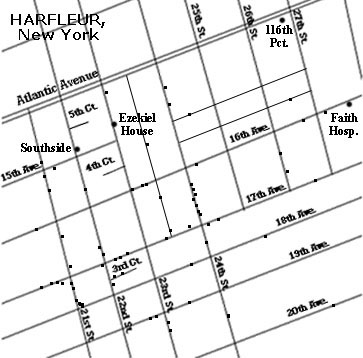By Shane Ivey, (c) 1998
Toxicology reports from recent arrests and deaths in the Harfleur region of Queens, New York indicate rapidly increasing usage of a previously unknown narcotic drug. Contacts in the area report that the drug is mainly being used by a subset of the sizeable Haitian community in Harfleur. They call the drug “Dreaming Man.” It is known to be distributed by a local Haitian gang or “posse.” Due to the insular nature of the gang and the community, however, attempts to determine the source of the drug have been unsuccessful.
The appearance of the Dreaming Man drug coincides with recent allegations of federal agents’ participation in narcotics trafficking in the Harfleur area. The Reverend Thomson Ezekiel of Southside AME Church (22nd Street, Harfleur) has on several occasions in the past two months made reference to having witnessed such participation. Note, however, that preliminary investigation of these allegations uncovered no corroborating evidence.
Attached is a summary report of DEA analysis of “Dreaming Man.” A recent victim of the drug, Anton Royce, remains under observation in the psychiatric ward of Faith Hospital in Queens, New York. The unusual nature and properties of the compound and the coincidence of allegations of official involvement in its distribution warrant careful investigation.
The Delta Green liaison for this operation is Supervisory Special Agent Andre Jones (Agent OSBORNE), Drug Enforcement Administration, New York Division.
‘DREAMING MAN’ CHEMICAL ANALYSIS
Chemical analysis of the “Dreaming Man” drug has been conducted by chemists with Delta Green clearance within the past three months. They concluded that the drug is synthetic, combining laboratory-mixed stimulants with an unknown organic compound which could not be positively identified as either animal or vegetable in nature. Studies of the organic element’s properties have been inconclusive. It is not carbon-based; nor is it based on any identified element.
The effect of ingestion is most acute when the bluish-black flakes are burned and the fumes inhaled, but longer-lasting effects can be achieved with oral and especially with intravenous ingestion, typically by mixing the flakes with water for an appropriate medium. Users under the influence of the drug report a sense of dissociation from reality, vertigo, ennui, hunger, and unnatural perceptions of distance and time. More unusual, however, is the fact these effects are sometimes experienced by individuals near a user who have not taken the drug themselves. Such transference of effect has been observed after presence for five minutes at a of proximity of about six feet. The cause of this effect is unknown.
The drug is physically addictive. The addictive component seems to be the unknown organic element, since the stimulants used are not known to produce such severe dependency. Withdrawal usually occurs after six or seven ingestions of the drug over a period of ten to twenty days. Withdrawal is more pronounced for heavier users. It typically sets in after twenty-four hours, and is marked by muscle cramps and spasms, cyanosis, nausea, vertigo, fever, and violent but vague hallucinations.
When cultured, the inert organic element of the drug undergoes startling revitalization, becoming a living organism within the host system. Additonal samples of the inert organic element perform in the same manner, but they also combine with the animate element within the host system to form a single living organic mass in symbiosis with the host cells. Removed from the host system, the organic element returns to its inert state.
These effects were the same regardless of the physical state of the drug from which the sample came. An organic element rendered gaseous resolidified and became animate when introduced to a host organism, and then combined with a prior animate sample.
REV. EZEKIEL’S SPEECH
The footage is digital, high resolution but with the shakiness of a portable and probably concealable unit. The scene is apparently a church sermon. The view is often obstructed by the nodding heads of congregants. At the pulpit is a tall, clean-shaven African American man wearing an expensive business suit. He punctuates his speech with angry gesticulation.
“With our own EYES we have seen them, the white devils of the CIA,” he cries, and the crowd groans angrily, “and the DEA,” the crowd croans again, “and the FBI,” there are still louder groans and shouts of indignation, “bringing the plague of drugs to our streets, to our front doors and our school-yards! With our own EYES we have seen them, speaking one to another in the shadows of night, trading promises and purses of silver. We have SEEN them, my brothers and sisters, and the time has come for the world to know. We are ON to you!”
ABOUT HARFLEUR, NY
Harfleur was incorporated in the early 1950s in a period of post-war urban growth, a residential area which quickly lost its initial affluence as the suburbs grew and attracted the successful urban middle class. It is now an area of high crime rates, high unemployment, and low income. It is divided into several distinct neighborhoods along primarily cultural and ethnic lines. The largest communities are Haitian and African-American in origin, with a significant Puerto Rican population in the western blocks.
Major known criminal elements include a Jamaican gang or “posse” known as the Third Court Warriors, another gang which claims affiliation with the Bloods of Los Angeles, and several known narcotics dealers. Fights between the Harfleur gangs are infrequent but bloody.
Officer Leroy Lemonde of the New York City Police Department is the community policing liason for Harfleur. Special Agent Jessica Morgan of the DEA is responsible for local investigations and coordination with the Queens County Narcotics Task Force.






